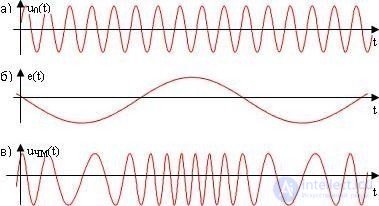Lecture
If at amplitude modulation the frequency ω 0 and the initial phase φ of the carrier range *** remain unchanged, and according to the law of the transmitted message e (t) the amplitude U 0 changes, then at angular modulation the amplitude U 0 remains constant, and the frequency or initial phase carrying col ***. Since the frequency and the initial phase are components of the generalized carrier angle of the collision [ω (t) + φ (t)], such a modulation is called angular. Depending on which of the parameters of the generalized angle, the frequency ω (t) or the initial phase φ (e), carries information about the transmitted message e (t), they distinguish frequency or phase modulation.
With frequency modulation, the amplitude of the carrier range *** of U 0 is kept constant, and the frequency of the carrier range of *** *** ω (t) is determined by the modulating signal e (t) in accordance with the expression:
ω (t) = ω 0 + k World Cup e (t), (5.8)
where k FM is a proportionality coefficient, connecting the deviation Δω of the FM frequency ω (t) from its nominal value ω 0 , equal to Δω FM = ω (t) - ω 0 , and the magnitude of the modulating voltage e (t) causing this deviation. The maximum frequency deviation caused by the maximum modulating voltage is called frequency deviation.
With a modulating signal in the form of a harmonic voltage
e (t) = E cos (´Ωt + Θ)
the instantaneous frequency of the frequency-modulated cola *** ing changes according to the lawω (t) = ω 0 + k World Cup E cos (´Ωt +) (5.9)
Timing diagrams of the carrier and modulating collar *** as well as the frequency-modulated signal are shown in Figure 5.4.
Fig. 5.4 Frequency modulation:
a) collation with a constant frequency; b) modulating signal; c) frequency-modulated col. ***
The relationship between the spectra of the modulating and generated frequency-modulated signal is not expressed by such simple expressions as in amplitude modulation, and is determined by the ratio between the frequency deviation of the resulting frequency-modulated collar *** caused by the modulating signal and the rate of change of this frequency deviation.
In particular, let tone modulation with a harmonic signal with a frequency ´Ω causes a frequency deviation with a deviation equal to Δω FM . Then, in the case of “fast” modulation (at Δω of the FM << ´Ω), the frequency band occupied by the frequency-modulated collar *** is determined by the highest frequency of the spectrum of the modulating signal
P FM ~ 2 ´Ω. (5.10)
In the case of “slow” modulation (at Δω FM >> ´Ω), the frequency range of the frequency-modulated colossus *** is determined by the frequency deviation Δω FM :
P FM ~ 2 Δω FM . (5.11)
Comments
To leave a comment
Devices for the reception and processing of radio signals, Transmission, reception and processing of signals
Terms: Devices for the reception and processing of radio signals, Transmission, reception and processing of signals